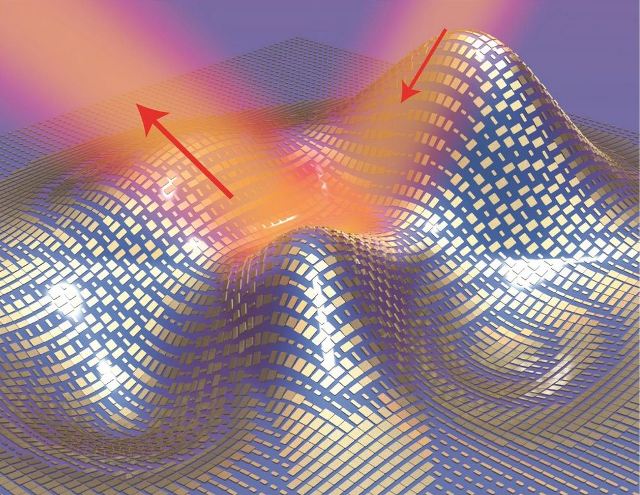Researchers at the U.S. Department of Energy (DOE)’s Lawrence Berkeley National Laboratory (Berkeley Lab), and the University of California (UC), Berkeley, have collaborated to create a microscopic, ultrathin invisibility “skin” cloak that has the ability to conceal 3D objects of arbitrary shape from detection using visible light.
 A 3D illustration of a metasurface skin cloak made from an ultrathin layer of nanoantennas (gold blocks) covering an arbitrarily shaped object. Light reflects off the cloak (red arrows) as if it were reflecting off a flat mirror.
A 3D illustration of a metasurface skin cloak made from an ultrathin layer of nanoantennas (gold blocks) covering an arbitrarily shaped object. Light reflects off the cloak (red arrows) as if it were reflecting off a flat mirror.
The principles involved in the design of the microscopic cloak could possibly be scaled up for concealing objects on a macroscopic scale. The thickness of the ultra-thin “skin cloak” was just 80 nm, and the team wrapped this cloak around an arbitrarily-shaped 3D object that had numerous dents and bumps.
The size of this object was approximately the size of a couple of biological cells. The “skin cloak” was made using gold nanoantennas in the form of brick-like blocks.
“This is the first time a 3D object of arbitrary shape has been cloaked from visible light,” said Xiang Zhang, director of Berkeley Lab’s Materials Sciences Division and a world authority on metamaterials – artificial nanostructures engineered with electromagnetic properties not found in nature.
Zhang is a member of the Kavli Energy NanoSciences Institute at Berkeley, and holds the Ernest S. Kuh Endowed Chair at UC Berkeley. “Our ultra-thin cloak now looks like a coat. It is easy to design and implement, and is potentially scalable for hiding macroscopic objects,” Zhang added.
Objects can be detected and observed only due to the scattering that takes place when light interacts with matter. The optical properties of metamaterials are not due to their chemical composition, but due to their physical structure. Hence, usage of metamaterials could be used to circumvent the interaction of matter with light when natural materials are used.
Zhang’s research group has been conducting studies on the interaction of light with metamaterials for the past ten years. The researchers have been able to bend the path of light backwards, and curve the light path.
This capability has not been observed in natural materials. Their advancement has allowed them to make objects undetectable optically. The metamaterial-based optical carpet cloaks that they had created in the past were bulky and were difficult for scaling up. The object concealed by the cloak was invisible; however, the cloak itself was detectable due to the fact that a phase difference existed between the surrounding background and the cloaked region.
“Creating a carpet cloak that works in air was so difficult we had to embed it in a dielectric prism that introduced an additional phase in the reflected light, which made the cloak visible by phase-sensitive detection,” says co-lead author Xingjie Ni, a recent member of Zhang’s research group who is now an assistant professor at Penn State University.
“Recent developments in metasurfaces, however, allow us to manipulate the phase of a propagating wave directly through the use of subwavelength-sized elements that locally tailor the electromagnetic response at the nanoscale, a response that is accompanied by dramatic light confinement.”
In the study, the researchers wrapped an arbitrarily shaped 3D sample object in the nanoantenna cloak. The area of the object was approximately 1,300 μm². When red light hit this object wrapped in the cloak, it got reflected in a manner similar to the reflection of light off a flat mirror, and this made the object invisible, even to phase-sensitive detection. Switching the nanoantenna polarization could turn on and turn off the cloak.
“A phase shift provided by each individual nanoantenna fully restores both the wavefront and the phase of the scattered light so that the object remains perfectly hidden,” says co-lead author Zi Jing Wong, also a member of Zhang’s research group.
Nanoantenna Invisibility Cloak Makes 3D Objects Disappear
When the cloak is turned “on,” the bump-shaped object being illuminated in the center white spot disappears from view. The object reappears when the cloak is turned “off.”
Berkeley Lab / Youtube
The capability to control the interactions between metamaterials and light holds great promise for superfast optical computers and high-resolution optical microscopes. As an example, micro scale invisibility skin cloaks could be used for hiding specific microelectronic component layouts and for security encryption. Macro scale invisibility cloaks could possibly be used for many applications, including 3D displays.
The study paper entitled, “An Ultra-Thin Invisibility Skin Cloak for Visible Light,” has been published in the journal Science.
The corresponding author of the paper is Zhang, and the lead authors are Xingjie Ni and Zi Jing Wong. Other co-authors of the paper are Yuan Wang and Michael Mrejen.
The DOE Office of Science funded this research.